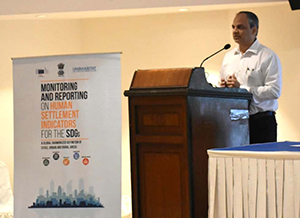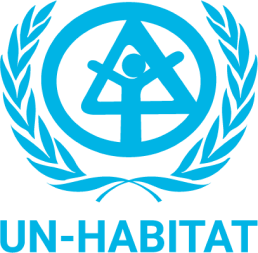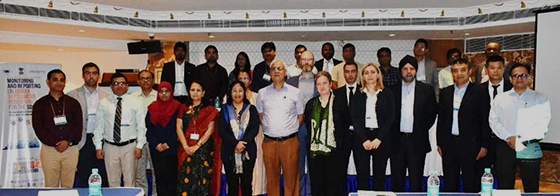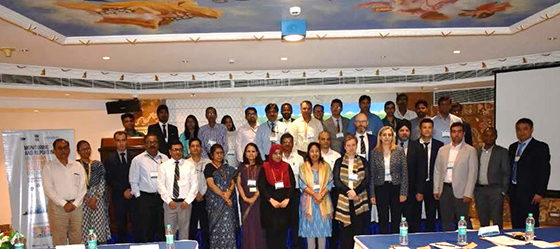26 September 2019, New Delhi – Countries in South and Central Asia are urbanizing rapidly resulting in densification and intensification of existing settlements, formation of extension areas beyond city boundaries, urban sprawl and “new cities”. Countries from the region use a diverse set of approaches to define urban areas, which vary from legal and administrative delineations, type of economic activities, population-based measurements to existence of services.
The variation in defining parameters of “urban” make it difficult to compare urban-related indicators nationally, regionally and globally; and call for harmonization in the way settlements are defined. This is the crucial consensus by delegates from 10 countries in the region, who attended the technical regional workshop for local authorities and national statistical agencies.
According to Mr. Pravin Srivastava, Secretary and Chief Statistician of India (CSI), Ministry of Statistics and Programme Implementation, Government of India, “actions towards sustainable development requires a clear understanding on what can be measured, and assessing progress in a manner that enables us to both recognize/appreciate specific issues and compare performance. This calls for harmonization in the way we define our settlements.”
Similar sentiments were echoed by Mr. Durga Shanker Mishra, Secretary, Ministry of Housing and Urban Affairs (MoHUA), Government of India who pointed out the need for clear understanding of prevailing country definitions, their significance, and wide consultations on the implications of such an approach to data production and decision making processes at the country level. He explained the complexity of political economy where “legal institutions, urban development authorities, special development authorities, and census officials have the ability to autonomously and legally designate whether an area is urban or not.” Mr. Mishra also stressed the role of cities in meeting the aspirations of its people. “Aiming for Ease-of-Living and SDG-11 will make cities better to live in. Capturing data leads to informed decision-making, and that is why we have established an Urban Observatory.

Day 1: Mr. Pravin Srivastava, Secretary and Chief Statistician of
India (CSI), Ministry of Statistics and Programme Implementation,
Government of India, calling for consensus between stakeholders.
Day 2: Mr. Durga Shanker Mishra, Secretary, Ministry of Housing
and Urban Affairs (MoHUA), Government of India, highlighting
initiatives that use data to drive policy.
The New Delhi workshop was the sixth out of seven workshops jointly organized by UN-Habitat, the European Commission, the UN Food and Agriculture Organization (FAO) and other partners who are part of a global voluntary commitment working toward a globally harmonized city/ urban and rural area definition. The workshop discussed various tools and techniques to build country-level capacity to support SDG 11 monitoring and reporting, with a focus on spatial and non-spatial methods of data collection and measurement to report on performance across all urban-related SDG indicators. And it introduced countries in South and Central Asia to the Degree of Urbanization (DEGURBA) approach, and how its application can support urban monitoring (SDG 11) and enable comparability of data across cities and countries. The DEGURBA approach evaluates whether an area is a city, town or rural area based on uniform grids (squares) measuring one square kilometer. The character of each grid is assessed based on its population density, and the total population of continuous grids determines if they collectively constitute a city, town or rural area.
A majority of the countries highlighted that the main obstacle in applying the DEGURBA method is the lack of well-defined administrative boundaries to disaggregate data. Other challenges include-access to satellite images, technical knowledge and capacities, timing for population data collection, uniform data generation mechanisms, and that the application of the method is sensitive to the quality of the existing data. Therefore, the way forward is to engage in technical and practical capacity building, piloting with a sample of settlements to keep costs down, and to improve the quality of the data collection mechanisms. Furthermore, policy makers, elected leaders, and technicians should be made aware of the opportunities of the integrating geospatial technology into statistics.
On the last day, Mr. O.P Ghosh, Deputy Director General, Social Statistics Division (SSD), MoSPI, India summarized the workshop stating, “we started off with many differences in the way we understand our settlements, but today, we finish with some level of consensus.” Ms. Hasmik Soghomonyan, Statistical Committee, Republic of Armenia, acknowledged the significance of DEGURBA for urban monitoring pointed out that countries in the region have rich data and substantial capacity that can help develop the method further. The consensus among all participants was that, DEGURBA offers unique opportunities for urban monitoring in all countries, but there is need for continued engagement between countries, UN-Habitat, the European Commission, other partners in the voluntary commitment, as well as among themselves for best practice transfer.
The consensus building and knowledge-sharing will continue at the seventh, international engagement workshop in Kuala Lumpur during the 3rd week of October.



